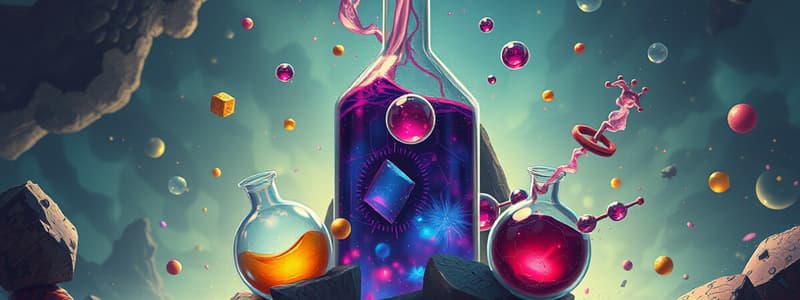Podcast
Questions and Answers
What is the charge of protons found in atoms?
What is the charge of protons found in atoms?
- Positively charged (correct)
- Variable charge
- Neutrally charged
- Negatively charged
Which state of matter has a definite shape and volume?
Which state of matter has a definite shape and volume?
- Liquid
- Gas
- Plasma
- Solid (correct)
What type of bond is formed by the transfer of electrons between atoms?
What type of bond is formed by the transfer of electrons between atoms?
- Ionic Bond (correct)
- Covalent Bond
- Metallic Bond
- Hydrogen Bond
In a chemical reaction, the substances that undergo change are known as:
In a chemical reaction, the substances that undergo change are known as:
Which of the following is NOT a type of chemical reaction?
Which of the following is NOT a type of chemical reaction?
What is the pH value of a neutral solution?
What is the pH value of a neutral solution?
What is the role of a base in a solution?
What is the role of a base in a solution?
Which type of reaction absorbs heat from the surroundings?
Which type of reaction absorbs heat from the surroundings?
Flashcards are hidden until you start studying
Study Notes
Basic Concepts
-
Atoms: Basic units of matter, composed of protons, neutrons, and electrons.
- Protons: Positively charged, found in the nucleus.
- Neutrons: Neutral, also in the nucleus.
- Electrons: Negatively charged, orbit the nucleus.
-
Molecules: Two or more atoms bonded together.
-
Compounds: Substances formed from two or more different elements in fixed ratios.
States of Matter
- Solid: Definite shape and volume; particles are tightly packed.
- Liquid: Definite volume but no definite shape; particles are close but can move past each other.
- Gas: Neither definite shape nor volume; particles are far apart and move freely.
Chemical Bonds
- Ionic Bonds: Formed through the transfer of electrons from one atom to another, resulting in charged ions.
- Covalent Bonds: Formed by the sharing of electrons between atoms.
- Metallic Bonds: Involves a 'sea of electrons' that are shared among a lattice of metal atoms.
Chemical Reactions
- Reactants and Products: Substances that undergo change (reactants) and the substances formed (products).
- Types of Reactions:
- Synthesis: A + B → AB
- Decomposition: AB → A + B
- Single Replacement: A + BC → AC + B
- Double Replacement: AB + CD → AD + CB
- Combustion: Hydrocarbon + O₂ → CO₂ + H₂O
Periodic Table
- Groups: Vertical columns, elements with similar properties.
- Periods: Horizontal rows, elements with increasing atomic number.
- Metals, Nonmetals, Metalloids: Distinction based on physical and chemical properties.
Acids and Bases
- Acids: Substances that donate protons (H⁺ ions) in solution.
- Example: HCl (hydrochloric acid)
- Bases: Substances that accept protons or donate hydroxide ions (OH⁻).
- Example: NaOH (sodium hydroxide)
- pH Scale: Measures acidity or basicity, ranging from 0 (acidic) to 14 (basic), with 7 being neutral.
Stoichiometry
- Molar Mass: Mass of one mole of a substance, expressed in grams/mol.
- Balancing Equations: Ensures the law of conservation of mass is followed in chemical reactions.
Thermochemistry
- Endothermic Reactions: Absorb heat, leading to a temperature drop in the surroundings.
- Exothermic Reactions: Release heat, leading to a temperature increase in the surroundings.
Organic Chemistry
- Hydrocarbons: Compounds composed of carbon and hydrogen.
- Alkanes: Saturated hydrocarbons (single bonds).
- Alkenes: Unsaturated hydrocarbons (at least one double bond).
- Alkynes: Unsaturated hydrocarbons (at least one triple bond).
Important Laws
- Law of Conservation of Mass: Mass is neither created nor destroyed in a chemical reaction.
- Avogadro’s Law: Equal volumes of gases at the same temperature and pressure contain equal number of molecules.
Safety in Chemistry
- Personal Protective Equipment (PPE): Safety goggles, gloves, lab coats.
- Chemical Safety: Proper labeling, storage, and disposal of chemicals; understanding Material Safety Data Sheets (MSDS).
Basic Concepts
- Atoms are the fundamental units of matter, made of protons (positive), neutrons (neutral), and electrons (negative).
- Molecules consist of two or more atoms bonded together, while compounds are specific types of molecules formed from two or more different elements in fixed ratios.
States of Matter
- Solids have a definite shape and volume; particles are closely packed and do not move freely.
- Liquids possess a definite volume but no fixed shape; particles are close but can flow past each other.
- Gases lack both definite shape and volume; particles are spread apart and move freely.
Chemical Bonds
- Ionic bonds occur through the transfer of electrons, creating charged ions.
- Covalent bonds involve the sharing of electrons between atoms.
- Metallic bonds feature a 'sea of electrons' shared among a lattice of metal atoms, allowing conductivity.
Chemical Reactions
- Reactants are the starting substances that undergo change, while products are the resulting substances.
- Types of chemical reactions include:
- Synthesis: Combining elements (A + B → AB).
- Decomposition: Breaking down compounds (AB → A + B).
- Single Replacement: One element replaces another (A + BC → AC + B).
- Double Replacement: Exchange of ions (AB + CD → AD + CB).
- Combustion: Reaction of hydrocarbons with oxygen, producing carbon dioxide and water (Hydrocarbon + O₂ → CO₂ + H₂O).
Periodic Table
- Groups are vertical columns featuring elements with similar properties, while periods are horizontal rows that increase in atomic number.
- Elements are categorized as metals, nonmetals, or metalloids based on their distinctive physical and chemical properties.
Acids and Bases
- Acids donate protons (H⁺ ions) in solution, exemplified by hydrochloric acid (HCl).
- Bases accept protons or donate hydroxide ions (OH⁻), demonstrated by sodium hydroxide (NaOH).
- The pH scale measures acidity/basicity, ranging from 0 (acidic) to 14 (basic), with 7 representing neutrality.
Stoichiometry
- Molar mass refers to the mass of one mole of a substance, expressed in grams per mole (g/mol).
- Balancing chemical equations is crucial to adhere to the law of conservation of mass during reactions.
Thermochemistry
- Endothermic reactions absorb heat, resulting in a temperature decrease in their surroundings.
- Exothermic reactions release heat, causing a temperature increase in their surroundings.
Organic Chemistry
- Hydrocarbons consist solely of carbon and hydrogen atoms.
- Alkanes are saturated hydrocarbons with single bonds; alkenes contain at least one double bond, while alkynes have at least one triple bond.
Important Laws
- The Law of Conservation of Mass asserts that mass is conserved in chemical reactions and is neither created nor destroyed.
- Avogadro’s Law states that equal volumes of gases contain an equal number of molecules at the same temperature and pressure.
Safety in Chemistry
- Personal Protective Equipment (PPE) includes safety goggles, gloves, and lab coats to protect against chemical exposure.
- Chemical safety involves correct labeling, storage, and disposal of chemicals, as well as understanding Material Safety Data Sheets (MSDS) for safe handling.
Studying That Suits You
Use AI to generate personalized quizzes and flashcards to suit your learning preferences.



